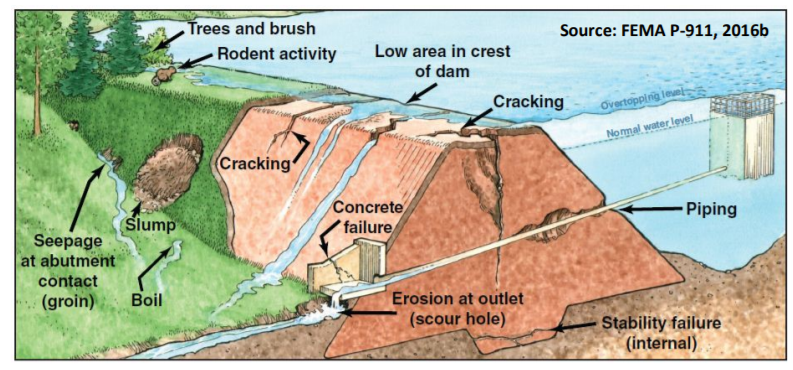Dam Safety Education - Dam Failures
Dams can fail in numerous ways. Some common issues that could lead to failures are presented in the illustration and table below. Any failure or potential emergency event requires the activation of the dam’s Emergency Action Plan.

Failure Type
Seepage and piping
- Seepage and piping can cause internal erosion within the dam that can erode embankment or foundation materials and lead to dam failure. Evidence of piping is generally detected at the location of seepage discharge.
Overtopping (hydrologic failure)
- Overtopping can cause erosion and head-cutting of embankment materials and can lead to dam failure
Deformation
- Deformation is caused by differential settlement; transverse or longitudinal cracking; or slope instability, slumps or other slope failures. Deformation can provide a path for seepage through the dam and lead to failure. Low areas in the crest of the dam can make the dam more vulnerable to overtopping.
Liquefaction
- Liquefaction can occur when the strength and stiffness of a saturated soil is reduced by earthquake shaking or other rapid loading. The weakened soil can cause the collapse of the dam.
Concrete failure
- Concrete failure, structural cracking, broken masonry and offsets at joints can lead to sudden failures.
Neglected maintenance and deterioration
- Neglected maintenance and deterioration can leave a dam vulnerable to several failure modes:
- Missing riprap can leave areas of an embankment unprotected and vulnerable to erosion from wave action or head-cutting during overtopping events.
- Woody vegetation growing on a dam can interfere with effective dam safety monitoring. Uprooted trees can create large voids in the embankment, and roots can create preferred seepage paths, causing internal erosion problems. Vegetation can also block spillways.
- Animal burrows in the embankment can cause preferred seepage paths. Livestock activity can damage embankment slopes and increase erosion potential.
- Malfunctioning gates, conduits or valves can reduce discharge capacity and cause the dam to overtop, which could lead to failure.
Other
- Other problems that can leave a dam vulnerable to failure include outdated designs; hydraulically inadequate spillways; and damage from vandalism, cyber-attacks or terrorism.
Emergency Action Plans
An Emergency Action Plan is a set of preplanned actions to be followed to minimize or alleviate emergency conditions at the dam. It contains procedures and information to assist the owner in issuing early warning notifications to minimize loss of life and property damage during an unusual or emergency event at the dam.
An EAP requires coordination among many organizations including the Virginia Department of Emergency Management and other public safety agencies such as police, fire and rescue, and transportation.
The EAP must be on file with VDEM. Requirements for EAPS are in the Virginia Administrative Code.

 Department of Conservation and Recreation
Department of Conservation and Recreation
 Department of Conservation and Recreation
Department of Conservation and Recreation


